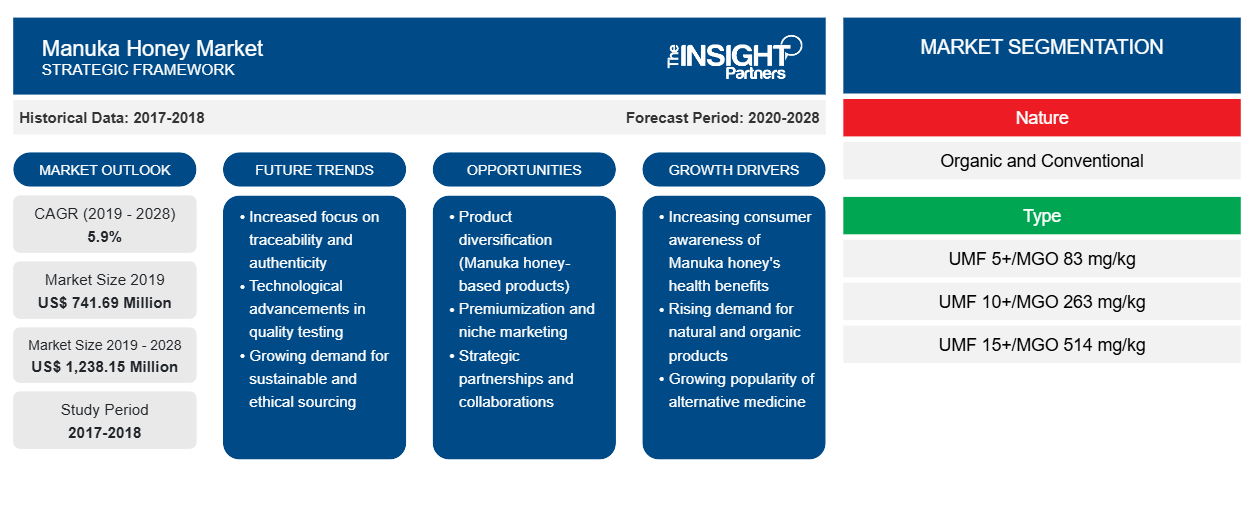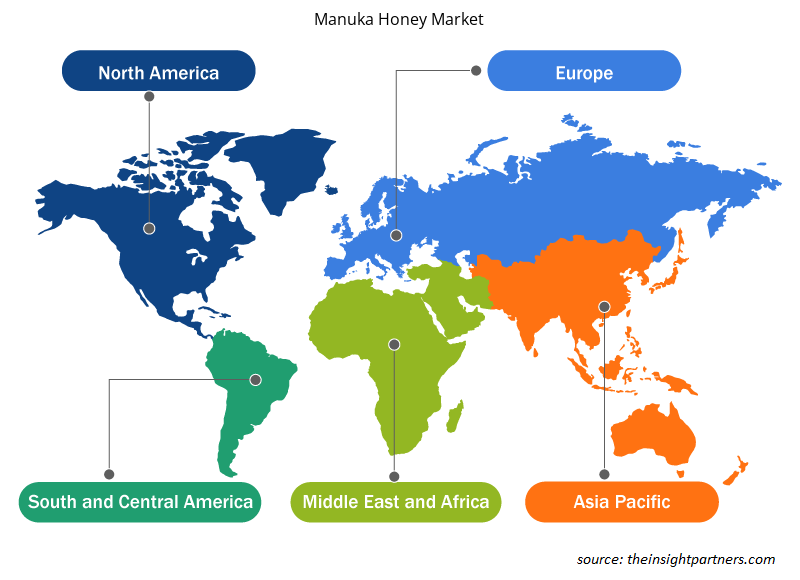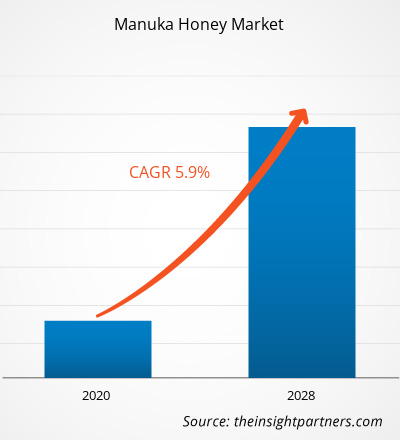The manuka honey market was valued at US$ 741.69 million in 2019, it is estimated to grow at a CAGR of 5.9% from 2020 to 2028.
Manuka honey is made from the nectar of the manuka tree and is only produced in Australia and New Zealand. The key active ingredient in Manuka honey is methylglyoxal. This is an antibacterial organic compound that can be used for both medicine and everyday health benefits. Consumer’s changing lifestyle, rising health concerns, increasing healthcare costs, and growing preference for a fit and active lifestyle are the key factors driving the demand for the manuka honey.
The manuka honey market in North America is expected to grow at the highest CAGR during the forecast period. Rapid growth in the snacking needs of children and the surge in the consumption of nutrient enriched food is fueling the growth of manuka honey market in North America. The manuka honey is used for making snacking bars whose recipes are provided by the companies. For instance, Comvita offers sweet & salty manuka magic bars recipe. The US is a major market for manuka honey in the North America region, followed by Canada and Mexico. The increase in consumer focus for maintaining fitness and regulating the body weight leads to the increasing demand for natural food products, which propels the growth of the manuka honey market. The presence of modern retail outlets such as supermarket & hypermarket in the US and Canada favors the market for manuka honey in these countries.
Customize This Report To Suit Your Requirement
You will get customization on any report - free of charge - including parts of this report, or country-level analysis, Excel Data pack, as well as avail great offers and discounts for start-ups & universities
Manuka Honey Market: Strategic Insights

- Get Top Key Market Trends of this report.This FREE sample will include data analysis, ranging from market trends to estimates and forecasts.
You will get customization on any report - free of charge - including parts of this report, or country-level analysis, Excel Data pack, as well as avail great offers and discounts for start-ups & universities
Manuka Honey Market: Strategic Insights

- Get Top Key Market Trends of this report.This FREE sample will include data analysis, ranging from market trends to estimates and forecasts.
Effect of COVID-19 on Manuka Honey Market
As of March 2021, the US, Brazil, India, Russia, Spain, and the UK are among the worst-affected countries in terms confirmed cases and reported deaths. The COVID-19 has been affecting economies and industries in various countries due to lockdowns, travel bans, and business shutdowns. The food and beverage industries are one of the significant sectors suffering from severe disruptions such as supply chain breaks, shutdown of production plants, etc., because of this outbreak. Asian countries are the global hub of food and beverage, and they are among the largest raw material suppliers for various industries. The shutdown of various plants and factories in these countries are affecting the global supply chains and negatively impacting the manufacturing, delivery schedules, and sales of various goods. Various companies have already announced possible delays in product deliveries and slump in future sales of their products. In addition, the global travel bans imposed by countries in Europe, Asia, and North America are suppressing the business collaboration and partnership opportunities. Thus, these factors have been restraining the growth of the food and beverage industry, and othermarkets related to this industry.
Market Insights
Increasing Use of Manuka Honey in Medical Industry
Researchers and pharmacists worldwide are working to discover the potentials of manuka honey in pharmaceutical formulations due to the improved functionalities and applicability of manuka honey. The importance of organic products has been understood in the wake of alarming health issues coupled with rising consciousness about organic certifications and preference for high-quality products. The antibacterial properties of manuka honey make it a perfect component for medicines. Moreover, it is used as a natural ointment for all kinds of injuries and has been recognized as a go-to virus fighter in an age of resistance to traditional antibiotics. Manuka honey medicinal products are available in the form of tubes, tablets, capsules, soft gels, and gummies, among others. These medicinal products can treat various health-related issues, such as prevention from acne, sinus, sore throat, and treatment of a broad spectrum of surgical and chronic wounds. Other advantages of manuka honey include clearing infections, clearing up blemishes on skin, helping heal cuts and scrapes, easing stomach aches, boosting the immune system, providing energy, and improving digestion.
The manuka honey is possibly the most stimulating medical-grade products used in hospitals to skin infections and heal wounds, mainly those non-responsive to standard treatments such as bacteria that are resilient to antibiotics. Rising antibiotic resistance is currently one of the world's most prevailing human health issues. Consumer’s changing lifestyle, rising health concerns, increasing healthcare costs, and growing preference for a fit and active lifestyle are the key factors driving the demand for the manuka honey. Therefore, the robust application of manuka honey in almost all health conditions coupled with increasing consumer preference for honey to achieve an active and disease-free life, is anticipated to propel the demand for manuka honey in the medical industry in the coming years.
Source Insights
Based on nature, the manuka honey market has been segmented into organic and conventional. The conventional segment accounted for a larger market share in 2019, and the organic segment is expected to register a higher CAGR in the market during the forecast period. Organic farming is the technique that involves the production of manuka honey without the use of artificial fertilizers, pesticides, or growth regulators on the agricultural land. The organic manuka honey contains an organic molecule called Methylglyoxal (MG), which is an antibacterial component. The manuka honey boosts the immune system by enhancing resistance to common infections and promoting mild burns or wounds and sore throat. The rate of organic farming of manuka honey has increased with the increase in cultivation area and the rising support from processing company. The major factor influencing the growers to adopt organic agriculture is the growing preference toward organic and healthy produce. The increasing demand of consumers for organic manuka honey has motivated the companies and the cultivators to promote organic farming, thus driving the segment growth.
Type Insights
Based on type, the manuka honey market has been segmented into UMF 5+/MGO 83 mg/kg (ppm), UMF 10+/MGO 263 mg/kg (ppm), UMF 15+/MGO 514 mg/kg (ppm), and UMF 20+/MGO 829 mg/kg (ppm). The UMF 15+/MGO 514 mg/kg (ppm) segment accounted for a larger market share in 2019, and the UMF 20+/MGO 829 mg/kg (ppm) segment is expected to register the highest CAGR in the market during the forecast period. UMF 15+/MGO 514 mg/kg (ppm) manuka honey contains minimum of 514 mg/kg MGO (methylglyoxal) levels. It is a premium pure manuka honey that offers top-range effectiveness. The high UMF level of manuka concentration provides UMF 15+/MGO 514 mg/kg (ppm) manuka honey an herbaceous flavour and dark colour. The manufacturers are offering UMF 15+/MGO 514 mg/kg (ppm) manuka honey, which is entirely unpasteurized and non-GMO. Also, they avoid excess heat-treating, which can damage the UMF levels and the quality of honey. The availability of unpasteurized and non-GMO UMF 15+/MGO 514 mg/kg (ppm) manuka honey with zero additives or preservatives is increasing the popularity of UMF 15+/MGO 514 mg/kg (ppm) manuka honey among the consumers, thereby driving the segment growth.
Distribution Channel Insights
Based on distribution channel, the manuka honey market has been segmented into supermarkets/hypermarkets, convenience stores, online stores, and others. The supermarkets/hypermarkets segment accounted for the largest market share in 2019, and the online segment is expected to register the highest CAGR in the market during the forecast period. The sales of manuka honey in supermarkets/hypermarkets are increasing owing to the increasing footfall at these places, especially from the middle-class buyers. High footfall in supermarkets/hypermarkets makes it easy for the manufacturers to target their customer base. Also, the wide availability of manuka honey products from various brands has encouraged customers to buy manuka honeys from supermarkets/hypermarkets.
The players operating in the manuka honey market include Arataki Honey, Capilano Honey Ltd., COMVITA, Kirksbees Honey, Manuka Health, Midland Holdings, and Oha Honey. The key companies implement the mergers and acquisitions, and research and development strategies to expand customer base and gain significant share in the global market, which also allows them to maintain their brand name globally.
Report Spotlights
- Progressive industry trends in the manuka honey market to help players develop effective long-term strategies
- Business growth strategies adopted by developed and developing markets
- Quantitative analysis of the manuka honey market from 2018 to 2028
- Estimation of global demand for manuka honey
- PEST analysis to illustrate the efficacy of buyers and suppliers operating in the industry
- Recent developments to understand the competitive market scenario
- Market trends and outlook as well as factors driving and restraining the growth of the manuka honey market
- Assistance in decision-making process by highlighting market strategies that underpin commercial interest, leading to the market growth
- The size of the manuka honey market size at various nodes
- Detailed overview and segmentation of the market, as well as the manuka honey industry dynamics
- Size of the manuka honey market in various regions with promising growth opportunities
Manuka Honey Market Regional Insights
The regional trends and factors influencing the Manuka Honey Market throughout the forecast period have been thoroughly explained by the analysts at The Insight Partners. This section also discusses Manuka Honey Market segments and geography across North America, Europe, Asia Pacific, Middle East and Africa, and South and Central America.

- Get the Regional Specific Data for Manuka Honey Market
Manuka Honey Market Report Scope
| Report Attribute | Details |
|---|---|
| Market size in 2019 | US$ 741.69 Million |
| Market Size by 2028 | US$ 1,238.15 Million |
| Global CAGR (2019 - 2028) | 5.9% |
| Historical Data | 2017-2018 |
| Forecast period | 2020-2028 |
| Segments Covered |
By Nature
|
| Regions and Countries Covered | North America
|
| Market leaders and key company profiles |
Manuka Honey Market Players Density: Understanding Its Impact on Business Dynamics
The Manuka Honey Market is growing rapidly, driven by increasing end-user demand due to factors such as evolving consumer preferences, technological advancements, and greater awareness of the product's benefits. As demand rises, businesses are expanding their offerings, innovating to meet consumer needs, and capitalizing on emerging trends, which further fuels market growth.
Market players density refers to the distribution of firms or companies operating within a particular market or industry. It indicates how many competitors (market players) are present in a given market space relative to its size or total market value.
Major Companies operating in the Manuka Honey Market are:
- Arataki Honey
- Capilano Honey Ltd.
- COMVITA
- Kirksbees Honey
- Manuka Health
Disclaimer: The companies listed above are not ranked in any particular order.

- Get the Manuka Honey Market top key players overview
Manuka Honey Market – by Nature
- Organic
- Conventional
Manuka Honey Market – by Type
- UMF 5+/MGO 83 mg/kg (ppm)
- UMF 10+/MGO 263 mg/kg (ppm)
- UMF 15+/MGO 514 mg/kg (ppm)
- UMF 20+/MGO 829 mg/kg (ppm)
Manuka Honey Market – by Distribution Channel
- Supermarkets/Hypermarkets
- Convenience Stores
- Online Stores
- Others
Company Profiles
- Arataki Honey
- Capilano Honey Ltd.
- COMVITA
- Kirksbees Honey
- Manuka Health
- Midland Holdings
- OHA Honey
- Pure Honey New Zealand
- Streamland Biological Technology Limited
- Watson And Sons
Frequently Asked Questions
Based on product type, which segment is leading the global manuka honey market during the forecast period?
Among the segments of type, 15+/MGO 514 mg/kg (ppm) segment has led the market in 2019. UMF 15+/MGO 514 mg/kg (ppm) manuka honey contains minimum of 514 mg/kg MGO (methylglyoxal) levels. It is a premium pure manuka honey that offers top-range effectiveness. The high UMF level of manuka concentration provides UMF 15+/MGO 514 mg/kg (ppm) manuka honey an herbaceous flavour and dark colour. The manufacturers are offering UMF 15+/MGO 514 mg/kg (ppm) manuka honey, which is entirely unpasteurized and non-GMO. Also, they avoid excess heat-treating, which can damage the UMF levels and the quality of honey. The availability of unpasteurized and non-GMO UMF 15+/MGO 514 mg/kg (ppm) manuka honey with zero additives or preservatives is increasing the popularity of UMF 15+/MGO 514 mg/kg (ppm) manuka honey among the consumers, thereby driving the segment growth.
Can you list some of the major players operating in the global manuka honey market?
The major players operating in the global hair extension market are Arataki Honey, Capilano Honey Ltd., COMVITA, Kirksbees Honey, Manuka Health, Midland Holdings and Oha Honey, and many others.
Which region held the largest share of the global manuka honey market?
In 2019, the manuka honey market was predominant by Asia Pacific at the global level. The manuka honey industry in the countries of Asia Pacific has experienced a huge shift over the years. China and India are among the leading manuka honey consuming countries across Asia Pacific. Increasing health awareness amongst the consumers further bolsters the market growth. The rising demand for healthy food is one of the main reasons that supports the growth of manuka honey in Asia Pacific. Hectic lifestyles along with wellness concerns have changed the eating patterns of the people, which favors the growth of manuka honey market in the region.
- Historical Analysis (2 Years), Base Year, Forecast (7 Years) with CAGR
- PEST and SWOT Analysis
- Market Size Value / Volume - Global, Regional, Country
- Industry and Competitive Landscape
- Excel Dataset
Testimonials
Reason to Buy
- Informed Decision-Making
- Understanding Market Dynamics
- Competitive Analysis
- Identifying Emerging Markets
- Customer Insights
- Market Forecasts
- Risk Mitigation
- Boosting Operational Efficiency
- Strategic Planning
- Investment Justification
- Tracking Industry Innovations
- Aligning with Regulatory Trends
Yes! We provide a free sample of the report, which includes Report Scope (Table of Contents), report structure, and selected insights to help you assess the value of the full report. Please click on the "Download Sample" button or contact us to receive your copy.
Absolutely — analyst assistance is part of the package. You can connect with our analyst post-purchase to clarify report insights, methodology or discuss how the findings apply to your business needs.
Once your order is successfully placed, you will receive a confirmation email along with your invoice.
• For published reports: You’ll receive access to the report within 4–6 working hours via a secured email sent to your email.
• For upcoming reports: Your order will be recorded as a pre-booking. Our team will share the estimated release date and keep you informed of any updates. As soon as the report is published, it will be delivered to your registered email.
We offer customization options to align the report with your specific objectives. Whether you need deeper insights into a particular region, industry segment, competitor analysis, or data cut, our research team can tailor the report accordingly. Please share your requirements with us, and we’ll be happy to provide a customized proposal or scope.
The report is available in either PDF format or as an Excel dataset, depending on the license you choose.
The PDF version provides the full analysis and visuals in a ready-to-read format. The Excel dataset includes all underlying data tables for easy manipulation and further analysis.
Please review the license options at checkout or contact us to confirm which formats are included with your purchase.
Our payment process is fully secure and PCI-DSS compliant.
We use trusted and encrypted payment gateways to ensure that all transactions are protected with industry-standard SSL encryption. Your payment details are never stored on our servers and are handled securely by certified third-party processors.
You can make your purchase with confidence, knowing your personal and financial information is safe with us.
Yes, we do offer special pricing for bulk purchases.
If you're interested in purchasing multiple reports, we’re happy to provide a customized bundle offer or volume-based discount tailored to your needs. Please contact our sales team with the list of reports you’re considering, and we’ll share a personalized quote.
Yes, absolutely.
Our team is available to help you make an informed decision. Whether you have questions about the report’s scope, methodology, customization options, or which license suits you best, we’re here to assist. Please reach out to us at sales@theinsightpartners.com, and one of our representatives will get in touch promptly.
Yes, a billing invoice will be automatically generated and sent to your registered email upon successful completion of your purchase.
If you need the invoice in a specific format or require additional details (such as company name, GST, or VAT information), feel free to contact us, and we’ll be happy to assist.
Yes, certainly.
If you encounter any difficulties accessing or receiving your report, our support team is ready to assist you. Simply reach out to us via email or live chat with your order information, and we’ll ensure the issue is resolved quickly so you can access your report without interruption.















The List of Companies - Manuka Honey Market
- Arataki Honey
- Capilano Honey Ltd.
- COMVITA
- Kirksbees Honey
- Manuka Health
- Midland Holdings
- OHA Honey
- Pure Honey New Zealand
- Streamland Biological Technology Limited
- Watson And Sons






 Get Free Sample For
Get Free Sample For